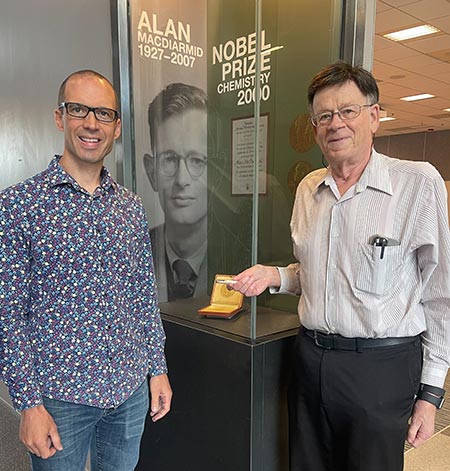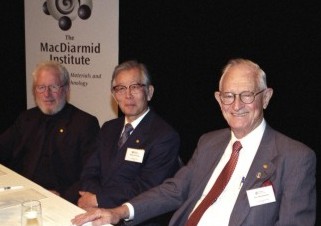Significant piece of science history donated to the University
27 February, 2024
If you're reading this on your mobile phone, you may be holding a piece of New Zealand Nobel Prize history.
Most of us don't realise that our mobile phones exist of today exist because of a discovery made in the 1970s by New Zealander Professor Alan MacDiarmid. Professor MacDiarmid shared the Nobel Prize for Chemistry in 2000 with Alan Heeger and Hideki Shirakawa for the discovery of 'conducting plastic', a seeming oxymoron that has had huge implications for electronics, computing, energy, telecommunications and even medicine.
Now for the first time New Zealand is home to an original sample of the conducting polymer, polyacetylene, for which Alan MacDiarmid's Nobel Prize was awarded. The piece of original material has been donated to the Institute by close friend of the late Professor Alan MacDiarmid, University of Utah Distinguished Emeritus Professor Joel S. Miller, who visited the MacDiarmid Institute in January to deliver a seminar and meet with MacDiarmid Institute researchers.

Professor Joel Miller (right) presenting MacDiarmid Institute Professor Justin Hodgkiss with the piece of conducting polymer for which Alan MacDiarmid's Nobel Prize was awarded
In donating this piece of Nobel Prize history, Professor Miller said he felt it would be meaningful for the material to reside at the MacDiarmid Institute, and be housed at Victoria University where Alan MacDiarmid had done his undergraduate and masters level science study.
"I considered gifting the material to Penn State University or a US museum, but I think the Institute is a great depository and (having the materials here) acknowledges the important contributions of Alan's.
"This is an authentic sample of the original polyacetylene, with Alan's handwriting on it."
The collaboration in the 1970s between Alan Heeger, Hideki Shirakawa and Alan MacDiarmid led to the discovery of conducting polymer specifically the creation of polyacetylene with conductivity almost as good as that of metallic copper when doped. Alan MacDiarmid could envision the potential for conducting polymers, but it wasn't until the early 2000s that the relevance of the discovery for electronics and computing technology became clear. Today conducting polymers are not only in our phones but in new solar cells and flexible, even wearable, electronic circuitry, biosensors, neural electrodes, drug delivery systems as well as telecommunication, electronics storage systems and more. In 2021 the Conductive Polymers Market size was estimated at USD 6.2 Bn.

Alan Heeger, Hideki Shirakawa and Alan MacDiarmid at AMN1 in 2003
Professor Miller, who first met Alan MacDiarmid in the early 1970s said he heard the Nobel Prize announcement before Alan MacDiarmid did.
"I'd turned up at my office at 7.30am and heard that the Nobel Prize in Chemistry had been awarded to Alan. I was delighted so I called him to congratulate him."
But Alan MacDiarmid wasn't picking up the phone.
"He acted like Alan and let the phone ring and ring and ring until the answerphone picked up. I was leaving a message saying 'Alan congratulations', and he picked the phone up and asked 'why are you congratulating me?' I told him he was going to have a very interesting day."
Professor Miller describes Alan MacDiarmid as a 'generous guy' who 'always had New Zealand in his heart'.
"Alan always seemed to have a smile," he said. "He was not there to find the negatives".
He said Alan was always very supportive of the research of others.
"Even if the research area was not fully understood, he'd be personally supportive of our research into totally new areas. I never saw him uncomplimentary," he said.
He says Alan MacDiarmid was also practical.
"He'd always want to go into the lab and do a few things. He was a hands-on person."
Akin to the seemingly contradictory nature of a conducting polymer, Professor Miller describes his friend as 'easy going, and intense'. He says he was often bewildered to hear that Alan MacDiarmid was off to China shortly after a blood transfusion (for the myelodysplastic syndrome that he developed in later life).
"He didn't let his illness stop him. He'd call me from a hospital while getting the transfusions."
Professor Miller recalls meeting up with his old friend at various MacDiarmid Institute conferences, for example in Queenstown, and thinks Alan MacDiarmid would be very happy with the Institute housing the piece of original material here at Te Herenga Waka Victoria University of Wellington.
"He'd be impressed at how the Institute has evolved."

The three Nobel laureates Alan MacDiarmid, Alan Heeger, and Hideki Shirakawa with Paul Callaghan


